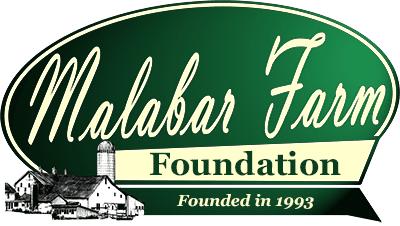Farm Animals & Livestock
**Please note that as a working farm our animals may not always been in the barn.**
The outside animal viewing areas are open during daylight hours. With over 300 acres of pasture, animals may be anywhere on the farm. Wild animals like deer, turkeys, ducks, hawks and bluebirds can be seen regularly along trails and roadsides on the farm.
WHAT ANIMALS YOU CAN SEE?
The wide selection of farm animals can be seen that were typical during Bromfield’s time in the 1940-50’s
- Beef Cows (mixed breeds)
- Shetland Pony (Misty)
- Miniature Horses
- Turkeys (wild and domestic)
- Chickens
- Goats
- Sheep
- Pigs
 Polled Hereford Cattle
Polled Hereford Cattle Boer-Nubian Mix Goats
Boer-Nubian Mix Goats
Polled Hereford Cattle
Hereford cattle are a beef cattle breed, widely used both in intemperate areas and temperate areas, mainly for meat production. The Polled Hereford breed is bred for its deep fore-quarters, depth and muscling, docile temperament, fast growing calves, and good quality of beef. Hereford cattle are also known to be easy breeders and easy calvers.
Boer-Nubian Mix Goats
The Anglo-Nubian, or simply Nubian in the United States, is a breed of domestic goat. The breed was developed in Great Britain of native milking stock and goats from the Middle East and North Africa. Its distinguishing characteristics include large, pendulous ears and a “Roman” nose. Due to their Middle-Eastern heritage, Anglo-Nubians can live in very hot climates and have a longer breeding season than other dairy goats. Considered a dairy or dual-purpose breed, Anglo-Nubians are known for the high butterfat content of their milk, although on average, the breed produces less volume of milk than other dairy breeds. Anglo-Nubians are large, with does weighing at least 135 lb. (61 kg.) and 175 lb. (79 kg) for bucks. The minimum height of the breed, measured at the withers, is 30 inches (76 cm) for does and 35 inches (88 cm) for bucks. Like most dairy goats, they are normally kept hornless by disbudding within approximately two weeks of birth.
Boer goats were likely developed in South America in the early 1900’s for meat production. Like the Nubian, they also have long pendulous ears. Characteristically they have white bodies and brown heads but can also have paint characteristics (brown/white patching on the body). Their name is derived from the Affrikaans (Dutch) word boer meaning farmer. The breed is noted for being docile, fast-growing and having high fertility rates and good carcass quality.
NEW ARRIVALS
The early spring (March- May) is a great time to witness the birth of many of our farm animals. During these months you will probably see lambs and goats, as well as new born turkeys, calves, and chicks, but there is no guarantee of it.
